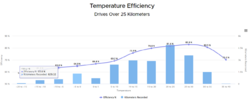Once a year I do this trip during the Xmas holidays to my folks home (400km/250mi). They live in a pretty rural area where charging infrastructure is abysmal. I have access to a SC where I am, but the only place to charge going towards my folks home is a level 3 at 300km/187mi away. Of course I'd leave with 100 % charge and precondition etc. etc., but we do not have a garage.
Additional info :
I've tried ABRP with very limited success in getting an answer to this question, mostly because I'm not actually sure what to expect in terms of wh/km to plug into the app.
Thanks for the help.
Additional info :
- Winter here can get to -30C/-20ish F. (rarely -40, normaly -20C/-4F)
- The speed limit on the road to my folks place is posted at 80km/50mi. I don't mind obeying it.
I've tried ABRP with very limited success in getting an answer to this question, mostly because I'm not actually sure what to expect in terms of wh/km to plug into the app.
Thanks for the help.



